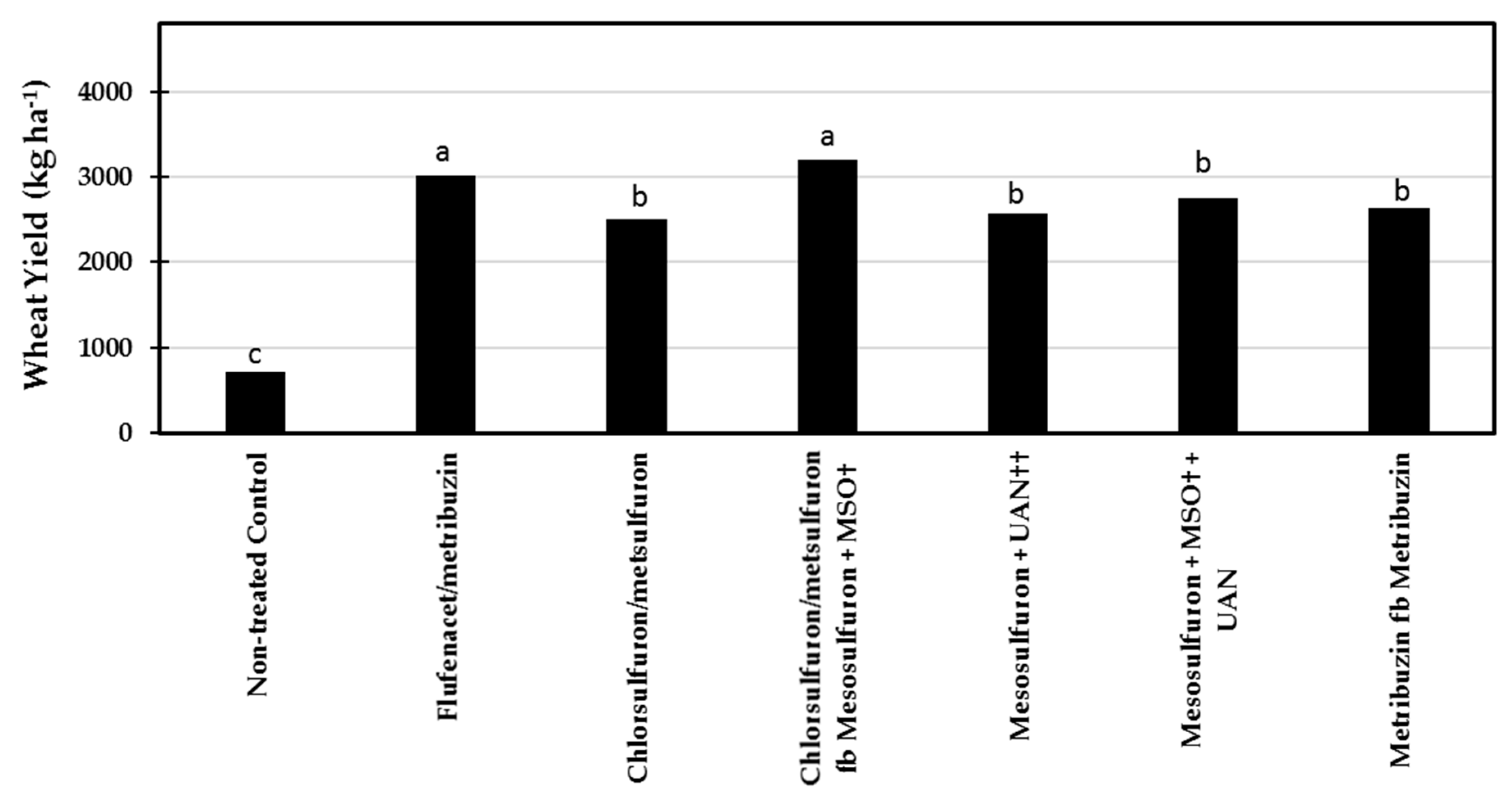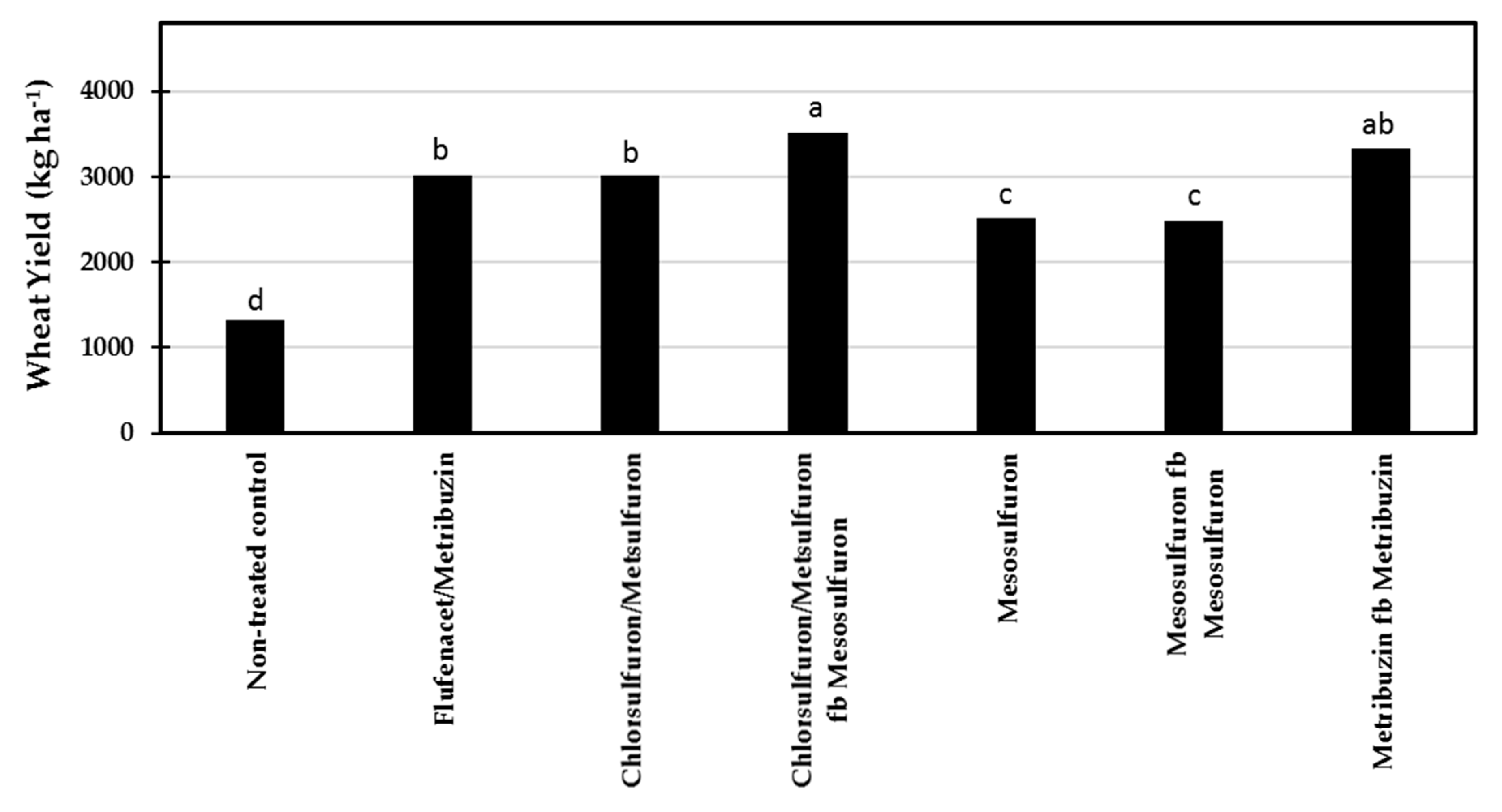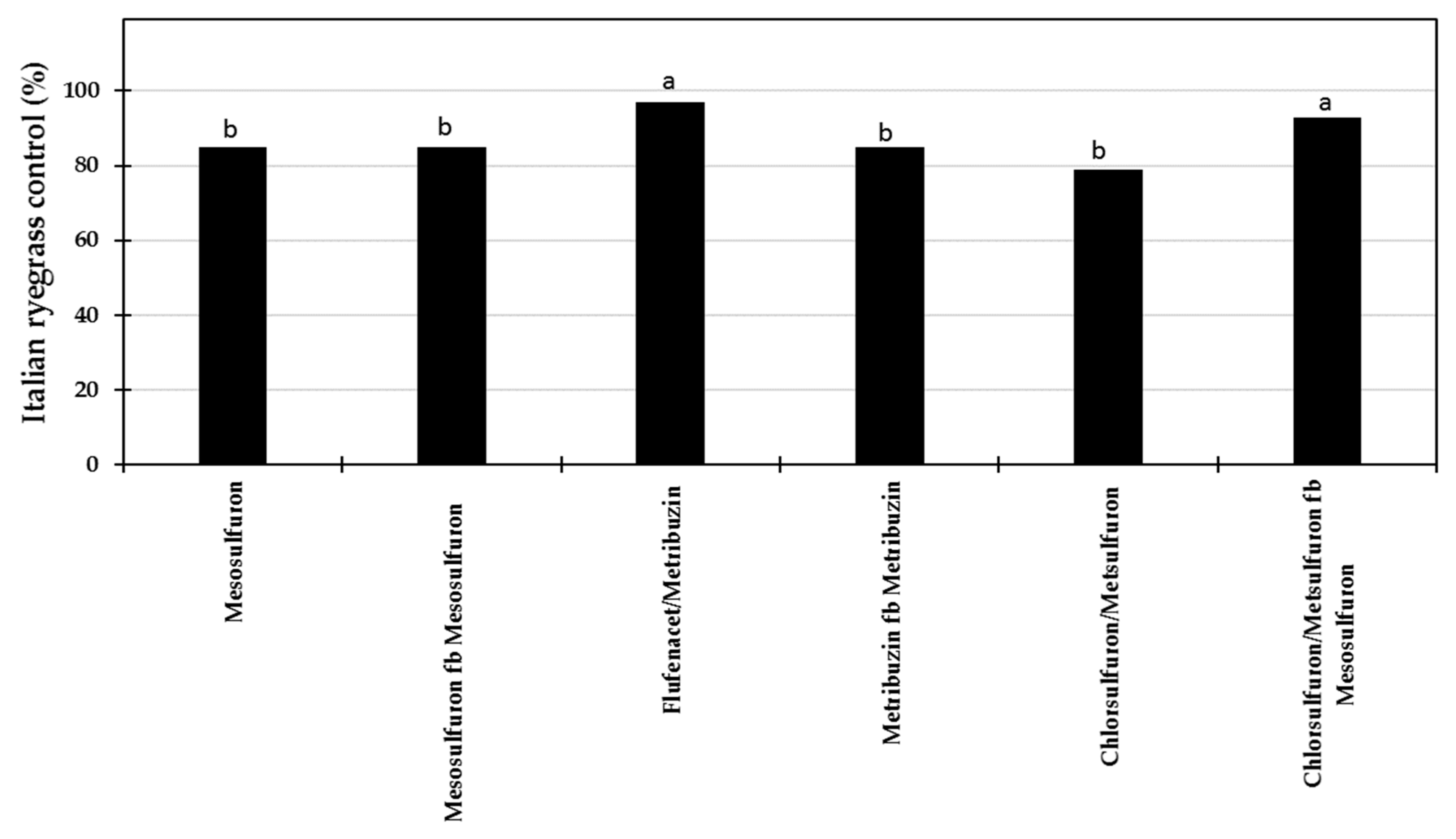Comparison of Herbicides for Control of Diclofop-Resistant Italian Ryegrass in Wheat
Abstract
:1. Introduction
2. Materials and Methods
3. Results
3.1. Weather Conditions during the Growing Seasons
3.2. 2001 through 2004
3.3. 2005 and 2006
3.4. 2007
4. Discussion
5. Conclusions
Author Contributions
Funding
Conflicts of Interest
References
- Shaner, D.L. Lessons learned from the history of herbicide resistance. Weed Sci. 2014, 62, 427–431. [Google Scholar] [CrossRef]
- Heap, I. The International Survey of Herbicide Resistant Weeds. 2015. Available online: www.weedscience.com (accessed on 4 April 2018).
- Bailey, W.A.; Wilson, H.P. Control of Italian ryegrass (Lolium multiflorum) in wheat (Triticum aestivum) with postemergence herbicides. Weed Technol. 2003, 17, 534–542. [Google Scholar] [CrossRef]
- Webster, T. Weed survey-southern states. Proc. South. Weed Sci. Soc. 2002, 55, 237–254. [Google Scholar]
- Elmore, C.D. Weed survey: Southern states: Grass crops subsection. Proc. South. Weed Sci. Soc. 1988, 41, 395–410. [Google Scholar]
- Bailey, W.A.; Hatzios, K.K.; Wilson, H.P. Responses of winter wheat and diclofop-methyl–sensitive and–resistant Italian ryegrass (Lolium multiflorum) to ae f130060 03. Weed Sci. 2003, 51, 515–522. [Google Scholar] [CrossRef]
- Bond, J.A.; Stephenson IV, D.O.; Barnes, J.W.; Bararpour, M.T.; Oliver, L.R. Diclofop-resistant Italian ryegrass (Lolium multiflorum) control in imidazolinone-tolerant wheat. Weed Technol. 2005, 19, 437–442. [Google Scholar] [CrossRef]
- Kuk, Y.-I.; Burgos, N.R.; Talbert, R.E. Cross-and multiple resistance of diclofop-resistant Lolium spp. Weed Sci. 2000, 48, 412–419. [Google Scholar] [CrossRef]
- Stanger, C.E.; Appleby, A.P. Italian ryegrass (Lolium multiflorum) accessions tolerant to diclofop. Weed Sci. 1989, 37, 350–352. [Google Scholar]
- Liebl, R.; Worsham, A.D. Interference of Italian ryegrass (Lolium multiflorum) in wheat (Triticum aestivum). Weed Sci. 1987, 35, 819–823. [Google Scholar]
- Appleby, A.; Olson, P.; Colbert, D. Winter wheat yield reduction from interference by Italian ryegrass 1. Agron. J. 1976, 68, 463–466. [Google Scholar] [CrossRef]
- Grey, T.L.; Bridges, D.C. Alternatives to diclofop for the control of Italian ryegrass (Lolium multiflorum) in winter wheat (Triticum aestivum). Weed Technol. 2003, 17, 219–223. [Google Scholar] [CrossRef]
- Senseman, S.A. Herbicide Handbook, 9th ed.; Weed Science Society of America: Lawrence, KS, USA, 2007. [Google Scholar]
- Bararpour, T.R.; Oliver, L.; Franklin, H.; Lyons, I.V. Hoelon-resistant Italian ryegrass control with pinoxaden (axial). In Proceedings of the Arkansas Crop Protection Association Conference, Fayetteville, AR, USA, 1–2 December 2008; Volume 12, pp. 16–17. [Google Scholar]
- Boeger, M.; Cederbaum, F.; Cornes, D.; Friedmann, A.; Glock, J.; Muehlebach, M.; Niderman, T. Milestones in the Discovery of Pinoxaden: A Unique Graminicide for Global Use in Cereal Crop; Axial Herbicide Release Publication; Syngenta Crop Protection AG: Basel, Switzerland, 2006. [Google Scholar]
- Ellis, A.T.; Steckel, L.E.; Main, C.L.; De Melo, M.S.; West, D.R.; Mueller, T.C. A survey for diclofop-methyl resistance in Italian ryegrass from Tennessee and how to manage resistance in wheat. Weed Technol. 2010, 24, 303–309. [Google Scholar] [CrossRef]
- Bailey, W.A.; Wilson, H.P.; Hines, T.E. Influence of ae f130060 03 application timing on Italian ryegrass (Lolium multiflorum) control. Weed Technol. 2003, 17, 842–853. [Google Scholar] [CrossRef]
- Barnes, M.A.; Peeper, T.F.; Epplin, F.M.; Krenzer, E.G., Jr. Effects of herbicides on Italian ryegrass (Lolium multiflorum), forage production, and economic returns from dual-purpose winter wheat (Triticum aestivum). Weed Technol. 2001, 15, 264–270. [Google Scholar] [CrossRef]
- Bond, J.A.; Eubank, T.W.; Bond, R.C.; Golden, B.R.; Edwards, H.M. Glyphosate-resistant Italian ryegrass (Lolium perenne ssp. multiflorum) control with fall-applied residual herbicides. Weed Technol. 2014, 28, 361–370. [Google Scholar]
- Clemmer, K.C.; York, A.C.; Brownie, C. Italian ryegrass (Lolium multiflorum) control in imidazolinone-resistant wheat. Weed Technol. 2004, 18, 481–489. [Google Scholar] [CrossRef]
- Bararpour, M.T.; Oliver, L.R. Comparison of wheat herbicides for control of diclofop-resistant Italian ryegrass. In Proceedings of the Arkansas Crop Protection Association Conference, Fayetteville, AR, USA, 26–27 November 2007; Volume 11, p. 1. [Google Scholar]
- Fayetteville Monthly/Yearly Rainfall. Available online: https://www.weather.gov/tsa/climo_fyv_pcp_monthv (accessed on 5 June 2018).
- Senseman, S.A. Summary of Herbicide Mechanism of Action: Fatty Acid and Lipid Biosynthesis Inhibitors; Weed Science Society of America: Lawrence, KS, USA, 2007. [Google Scholar]
- Grey, T.L.; Cutts III, G.S.; Sosnoskie, L.; Culpepper, A.S. Italian ryegrass (Lolium perenne) control and winter wheat response to post herbicides. Weed Technol. 2012, 26, 644–648. [Google Scholar] [CrossRef]
- Miller, P.; Westra, P. Herbicide Surfactants, and Adjuvants; Crop Series; Production No. 0.559; Colorado State University Cooperative Extension: Fort Collins, CO, USA; Available online: https://erams.com/static/wqtool/PDFs/bmps_colorado/00559.pdf (accessed on 20 June 2018).
- Gauvrit, C.; Cabanne, F. Oils for weed control: Uses and mode of action. Pest Manag. Sci. 1993, 37, 147–153. [Google Scholar] [CrossRef]
- Xu, L.-Y.; Zhu, H.; Ozkan, H.; Bagley, W.E.; Derksen, R.C.; Krause, C.R. Adjuvant effects on evaporation time and wetted area of droplets on waxy leaves. Trans. ASABE 2010, 53, 13–20. [Google Scholar] [CrossRef]
- Xu, L.; Zhu, H.; Ozkan, H.E.; Bagley, W.E.; Krause, C.R. Droplet evaporation and spread on waxy and hairy leaves associated with type and concentration of adjuvants. Pest Manag. Sci. 2011, 67, 842–851. [Google Scholar] [CrossRef] [PubMed]



| Year | Planting | Emergence | Harvest |
|---|---|---|---|
| 2001–2002 | 22-October | 1-November | 20-June |
| 2002–2003 | 23-October | 2-November | 16-June |
| 2003–2004 | 20-October | 25-October | 18-June |
| 2004–2005 | 21-October | 26-October | 28-June |
| 2005–2006 | 28-October | 5-November | 7-June |
| 2006–2007 | 24-October | 3-November | 25-June |
| Year | Herbicide Treatments (Common Names) | Trade Name | Manufacturer |
|---|---|---|---|
| 2001–2004 | Flufenacet/metribuzin | Axiom | Bayer CropScience, Research Triangle Park, North Carolina, USA |
| Chlorsulfuron/metsulfuron | Finesse | DuPont, Wilmington, Delaware, USA | |
| Chlorsulfuron/metsulfuron fb † Mesosulfuron + MSO | Finesse fb Osprey | Dupont; Bayer CropScience | |
| Mesosulfuron + UAN ‡ | Osprey | Bayer CropScience, Research Triangle Park, North Carolina, USA | |
| Mesosulfuron + MSO †† + UAN | Osprey | Bayer CropScience, Research Triangle Park, North Carolina, USA | |
| Metribuzin fb Metribuzin | Sencor fb Sencor | Bayer CropScience, Research Triangle Park, North Carolina, USA | |
| 2005–2007 | Flufenacet/Metribuzin | Axiom | Bayer CropScience, Research Triangle Park, North Carolina, USA |
| Chlorsulfuron/Metsulfuron | Finesse | DuPont, Wilmington, Delaware, USA | |
| Chlorsulfuron/Metsulfuron fb Mesosulfuron | Finesse fb Osprey | Dupont; Bayer CropScience | |
| Mesosulfuron | Osprey | Bayer CropScience, Research Triangle Park, North Carolina, USA | |
| Mesosulfuron fb Mesosulfuron | Osprey fb Osprey | Bayer CropScience, Research Triangle Park, North Carolina, USA | |
| Metribuzin fb Metribuzin | Sencor fb Sencor | Bayer CropScience, Research Triangle Park, North Carolina, USA |
| Year | Herbicide Treatments | Application Rate (kg ai ha−1) | Application Timing |
|---|---|---|---|
| 2001–2004 | Flufenacet/metribuzin | 0.476 | 1–2 leaf stage wheat |
| Chlorsulfuron/metsulfuron | 0.026 | PRE † | |
| Chlorsulfuron/metsulfuron fb † Mesosulfuron + MSO | 0.026 fb 0.048 | PRE; 3–4 leaf ryegrass | |
| Mesosulfuron + UAN ‡ | 0.048 | 1- to 2-tiller ryegrass | |
| Mesosulfuron + MSO †† + UAN | 0.048 | 1- to 2-tiller ryegrass | |
| Metribuzin fb Metribuzin | 0.280 fb 0.280 | 2–3 leaf stage wheat; 2–3 tiller wheat | |
| 2005–2007 | Flufenacet/Metribuzin | 0.476 | 1–2 leaf stage wheat |
| Chlorsulfuron/Metsulfuron | 0.026 | PRE | |
| Chlorsulfuron/Metsulfuron fb Mesosulfuron | 0.013 fb 0.015 | PRE; 3–4 leaf ryegrass | |
| Mesosulfuron | 0.015 | 1- to 2-tiller ryegrass | |
| Mesosulfuron fb Mesosulfuron | 0.008 fb 0.008 | 1–2-tiller ryegrass; 4-leaf to 2-tiller ryegrass | |
| Metribuzin fb Metribuzin | 0.280 fb 0.280 | 2–3 leaf stage wheat; 2–3 tiller stage wheat |
| Year | January | February | March | April | May | June | July | August | September | October | November | December | Annual Total/Average |
|---|---|---|---|---|---|---|---|---|---|---|---|---|---|
| Monthly Total Rainfall (mm) | |||||||||||||
| 2001 | 61 | 162 | 15 | 45 | 179 | 131 | 73 | 34 | 138 | 156 | 95 | 123 | 1213 |
| 2002 | 91 | 25 | 141 | 155 | 126 | 89 | 53 | 168 | 35 | 67 | 18 | 127 | 1095 |
| 2003 | 3 | 74 | 54 | 35 | 201 | 99 | 56 | 94 | 76 | 92 | 108 | 77 | 972 |
| 2004 | 50 | 30 | 74 | 287 | 57 | 185 | 201 | 17 | 14 | 140 | 153 | 30 | 1239 |
| 2005 | 141 | 52 | 49 | 92 | 85 | 112 | 36 | 42 | 92 | 46 | 27 | 10 | 783 |
| 2006 | 45 | 17 | 92 | 103 | 97 | 52 | 41 | 189 | 183 | 82 | 184 | 52 | 1137 |
| 2007 | 117 | 52 | 18 | 80 | 113 | 107 | 80 | 65 | 66 | 118 | 9 | 65 | 890 |
| Monthly Average Temperature (°C) | |||||||||||||
| 2001 | 0.7 | 5.4 | 6.5 | 16.8 | 18.4 | 22.3 | 26.4 | 25.8 | 19.4 | 13.5 | 11.4 | 4.6 | 14.3 |
| 2002 | 3.2 | 3.5 | 7.3 | 15.2 | 17.7 | 22.8 | 25.4 | 24.8 | 21.5 | 12.9 | 6.6 | 3.9 | 13.7 |
| 2003 | 0.9 | 2.3 | 8.8 | 14.3 | 18.5 | 20.9 | 25.4 | 26.0 | 18.7 | 15.1 | 10.1 | 4.2 | 13.8 |
| 2004 | 2.7 | 3.1 | 10.5 | 14.2 | 19.4 | 22.1 | 23.4 | 22.2 | 20.6 | 16.6 | 10.6 | 3.9 | 14.1 |
| 2005 | 5.3 | 6.7 | 7.8 | 13.7 | 17.7 | 23.5 | 25.3 | 26.6 | 23.4 | 15.1 | 10.2 | 2.4 | 14.8 |
| 2006 | 7.2 | 3.5 | 10.2 | 17.5 | 19.3 | 22.5 | 26.6 | 27.3 | 18.7 | 13.7 | 9.2 | 5.4 | 15.1 |
| 2007 | 1.2 | 3.3 | 13.4 | 11.7 | 19.7 | 23.0 | 24.4 | 27.1 | 21.7 | 16.5 | 9.6 | 4.3 | 14.7 |
| Year | Herbicide Treatments | Application Rate | Italian Ryegrass Control ‡ |
|---|---|---|---|
| kg ai ha−1 | % | ||
| 2001–2004 | Flufenacet/metribuzin | 0.476 | 87 a |
| Chlorsulfuron/metsulfuron | 0.026 | 58 b | |
| Chlorsulfuron/metsulfuron fb † Mesosulfuron + MSO † | 0.026 fb 0.048 | 89 a | |
| Mesosulfuron + UAN § | 0.048 | 65 b | |
| Mesosulfuron + MSO § + UAN | 0.048 | 85 a | |
| Metribuzin fb Metribuzin | 0.280 fb 0.280 | 82 a | |
| 2005–2006 | Flufenacet/Metribuzin | 0.476 | 89 abc |
| Chlorsulfuron/Metsulfuron | 0.026 | 89 abc | |
| Chlorsulfuron/Metsulfuron fb Mesosulfuron | 0.013 fb 0.015 | 92 ab | |
| Mesosulfuron | 0.015 | 86 bc | |
| Mesosulfuron fb Mesosulfuron | 0.008 fb 0.008 | 81 c | |
| Metribuzin fb Metribuzin | 0.280 fb 0.280 | 94 a |
© 2018 by the authors. Licensee MDPI, Basel, Switzerland. This article is an open access article distributed under the terms and conditions of the Creative Commons Attribution (CC BY) license (http://creativecommons.org/licenses/by/4.0/).
Share and Cite
Bararpour, T.; Hale, R.R.; Kaur, G.; Bond, J.A.; Burgos, N.R.; Tseng, T.-M.P.; Wilkerson, T.H.; Lazaro, L.M. Comparison of Herbicides for Control of Diclofop-Resistant Italian Ryegrass in Wheat. Agriculture 2018, 8, 135. https://doi.org/10.3390/agriculture8090135
Bararpour T, Hale RR, Kaur G, Bond JA, Burgos NR, Tseng T-MP, Wilkerson TH, Lazaro LM. Comparison of Herbicides for Control of Diclofop-Resistant Italian Ryegrass in Wheat. Agriculture. 2018; 8(9):135. https://doi.org/10.3390/agriculture8090135
Chicago/Turabian StyleBararpour, Taghi, Ralph R. Hale, Gurpreet Kaur, Jason A. Bond, Nilda R. Burgos, Te-Ming P. Tseng, Tessie H. Wilkerson, and Lauren M. Lazaro. 2018. "Comparison of Herbicides for Control of Diclofop-Resistant Italian Ryegrass in Wheat" Agriculture 8, no. 9: 135. https://doi.org/10.3390/agriculture8090135





